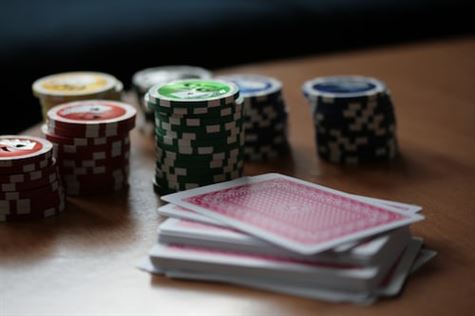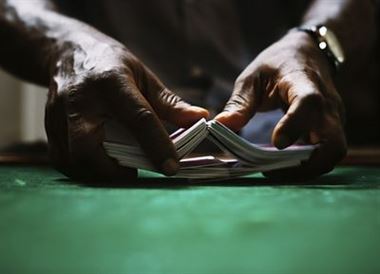Fold equity is a concept in poker that highlights the influence of mathematical calculations in bluffing and semi-bluffing situations. It refers to the probability of an opponent folding their hand when faced with a bet or raise. By understanding and utilizing fold equity, players can strategically manipulate their opponents’ decisions, even when their own hand may not be the strongest. This mathematical approach to bluffing and semi-bluffing can significantly impact the outcome of a poker game, making it a powerful tool in the hands of skilled players.
The Basics of Fold Equity in Poker: Understanding the Power of Math in Bluffing and Semi-Bluffing Situations
Fold equity is based on the principle that players will fold their hand if the expected value of calling a bet or raise is negative. In other words, if the potential loss outweighs the potential gain, players are more likely to fold. This is where the power of math comes into play.
To calculate fold equity, you need to consider several factors. First, you need to assess the strength of your own hand. The weaker your hand, the more likely your opponent is to fold. Second, you need to evaluate the range of hands your opponent is likely to have. If their range consists mostly of weak hands, your fold equity increases. Finally, you need to consider the size of your bet or raise. The larger the bet, the more likely your opponent is to fold.
Let’s say you have a mediocre hand, but you believe your opponent has an even weaker hand. By making a large bet, you can increase your fold equity and force your opponent to fold. This is known as a pure bluff. However, pure bluffs are risky because if your opponent calls, you will likely lose the hand. This is where semi-bluffing comes into play.
Semi-bluffing is a strategy that combines elements of both bluffing and value betting. It involves betting or raising with a hand that has the potential to improve, but is not currently the best hand. By semi-bluffing, you can increase your fold equity while also giving yourself a chance to win the hand if your opponent calls.
The power of math in semi-bluffing lies in calculating the probability of improving your hand. For example, let’s say you have a flush draw with two cards to come. There are nine cards of the same suit remaining in the deck, so you have a roughly 19% chance of hitting your flush on the next card. By considering the pot odds and the potential payoff if you hit your flush, you can determine whether it is profitable to semi-bluff.
If the pot odds are greater than the odds of hitting your flush, it is a profitable semi-bluff. This is because even if your opponent calls, you still have a chance to win the hand by hitting your flush. By semi-bluffing in this situation, you increase your fold equity and give yourself multiple ways to win the hand.
Maximizing Fold Equity: Strategies for Increasing Your Chances of Winning with Bluffs and Semi-Bluffs
To fully grasp the power of fold equity, it is important to understand the mathematics behind it. Fold equity is calculated by comparing the size of your bet or raise to the size of the pot. The larger your bet relative to the pot, the more likely your opponent is to fold. This is because they are risking more chips to potentially win a smaller pot, making it less profitable for them to continue playing.
One way to increase your fold equity is by making larger bets or raises. By putting more chips into the pot, you are increasing the risk for your opponent and making it less likely for them to call. However, it is important to strike a balance between maximizing fold equity and not risking too many chips on a bluff. It is crucial to consider the strength of your hand and the likelihood that your opponent will fold before deciding on the size of your bet.
Another strategy to maximize fold equity is through the use of semi-bluffs. A semi-bluff is a bet or raise made with a hand that is not currently the best, but has the potential to improve. By semi-bluffing, you are putting pressure on your opponent to fold, while also giving yourself a chance to win the pot if you do improve your hand. This increases your overall fold equity, as your opponent may be more inclined to fold knowing that you have the potential to make a strong hand.
When deciding whether to bluff or semi-bluff, it is important to consider the range of hands that your opponent is likely to have. If their range consists mostly of strong hands, bluffing may not be the best option, as they are less likely to fold. However, if their range is wide and contains many weak hands, bluffing can be a profitable move. By analyzing your opponent’s tendencies and hand ranges, you can make more informed decisions and increase your fold equity.
It is also important to be aware of your table image when attempting to maximize fold equity. If you have been playing tight and only showing strong hands, your opponents are more likely to give you credit for a strong hand when you make a bet or raise. This can increase your fold equity, as they may be more inclined to fold weaker hands. On the other hand, if you have been bluffing frequently, your opponents may be more likely to call or raise, reducing your fold equity. Adapting your strategy based on your table image can greatly impact your success in bluffing and semi-bluffing situations.
Calculating Fold Equity: How to Use Math to Determine the Effectiveness of Your Bluffing and Semi-Bluffing Moves
To determine the effectiveness of your bluffing or semi-bluffing moves, you need to consider several factors. The first is the strength of your hand. Bluffing with a weak hand is risky, as your opponent may call your bet and expose your bluff. On the other hand, having a strong hand reduces the need for bluffing, as you have a higher chance of winning the pot without resorting to deception.
The second factor to consider is the size of your bet. A larger bet increases the pressure on your opponent and makes it more likely for them to fold. However, it also increases the risk for you, as a larger bet means more money at stake. Finding the right balance between a bet that is large enough to induce a fold but not so large that it becomes too costly is crucial.
The third factor is the playing style of your opponent. Some players are more likely to fold than others, especially if they are conservative or risk-averse. By observing your opponent’s tendencies and understanding their playing style, you can better gauge their likelihood of folding and adjust your strategy accordingly.
Now, let’s delve into the math behind calculating fold equity. The formula for fold equity is relatively simple: fold equity = (chance of opponent folding) x (pot size + opponent’s bet). The chance of your opponent folding can be estimated based on their playing style, the strength of their hand, and their previous actions in the hand.
To illustrate this, let’s consider a hypothetical scenario. You are playing in a no-limit Texas Hold’em game, and the pot size is $100. Your opponent bets $50, and you believe that there is a 50% chance they will fold if you raise. Plugging these numbers into the fold equity formula, we get: fold equity = (0.5) x ($100 + $50) = $75.
This means that by bluffing or semi-bluffing, you have a fold equity of $75. In other words, if you make a bet or raise of $75 or more, your opponent would need to fold more than 50% of the time for your move to be profitable in the long run.
Calculating fold equity allows you to make informed decisions at the poker table. By considering the strength of your hand, the size of your bet, and the playing style of your opponent, you can estimate the likelihood of a successful bluff or semi-bluff. This mathematical approach takes the guesswork out of the equation and gives you a strategic advantage over your opponents.
Exploiting Fold Equity: Leveraging Your Opponents’ Tendencies to Gain an Edge in Poker
Bluffing and semi-bluffing are two key strategies that rely heavily on fold equity. Bluffing involves making a bet or raise with a weak hand in the hopes of convincing your opponents to fold their stronger hands. On the other hand, semi-bluffing involves betting or raising with a hand that has the potential to improve, but is not currently the best hand. Both strategies require a deep understanding of your opponents’ playing styles and the ability to calculate the likelihood of them folding.
To effectively exploit fold equity, you must first observe and analyze your opponents’ tendencies. Are they tight players who only play premium hands? Or are they loose players who play a wide range of hands? By paying attention to their betting patterns and hand selections, you can gain valuable insights into their decision-making process.
Once you have a good understanding of your opponents’ tendencies, you can start calculating the fold equity in different situations. This is where the power of math comes into play. By considering factors such as the size of your bet, the pot odds, and the likelihood of your opponents folding, you can determine whether a bluff or semi-bluff is likely to be successful.
For example, let’s say you have a flush draw on the turn, and the pot is $100. Your opponent bets $50, and you believe there is a 50% chance they will fold if you raise. In this scenario, you can calculate your fold equity by multiplying the probability of your opponent folding (50%) by the amount you stand to win if they fold ($150, which includes the pot and your opponent’s bet). The result, in this case, is a fold equity of $75.
Understanding fold equity allows you to make informed decisions based on the potential value of your bets and raises. If the fold equity is higher than the cost of your bet, it becomes a profitable move. However, if the fold equity is lower than the cost of your bet, it may not be worth the risk.
It’s important to note that fold equity is not a guaranteed strategy. Your opponents may be skilled players who can see through your bluffs or semi-bluffs. Therefore, it’s crucial to use fold equity as part of a larger strategy that includes a mix of strong hands, well-timed bluffs, and semi-bluffs.
Advanced Fold Equity Techniques: Taking Your Bluffing and Semi-Bluffing Game to the Next Level in Poker
When you bluff, you are essentially representing a stronger hand than you actually have. By doing so, you aim to convince your opponent that their hand is weaker and that folding is the best course of action. However, bluffing blindly without considering fold equity is a recipe for disaster.
To calculate fold equity, you need to consider several factors. First and foremost, you must assess the strength of your opponent’s hand. Are they likely to have a strong hand or a weak one? This evaluation will help you determine the likelihood of them folding.
Next, you need to consider the size of your bet or raise. The larger the bet, the more likely your opponent is to fold. This is because a larger bet represents a greater risk for them, and they may be unwilling to take that risk if they believe their hand is not strong enough.
Additionally, you should take into account the number of players involved in the hand. The more players there are, the less likely each individual player is to fold. This is because the pot odds become more favorable, making it more enticing for players to continue in the hand.
Understanding fold equity also plays a crucial role in semi-bluffing situations. A semi-bluff is when you have a drawing hand that has the potential to improve on future streets. By semi-bluffing, you not only have a chance to win the pot immediately if your opponent folds, but you also have the potential to win the pot if you hit your draw.
When semi-bluffing, you need to consider the same factors as when bluffing, but with an added layer of complexity. You must assess the likelihood of hitting your draw and weigh it against the potential fold equity. If the odds of hitting your draw are high and the fold equity is also significant, then a semi-bluff becomes a powerful weapon in your arsenal.
To maximize your fold equity, it is essential to pay attention to your table image. If you have been playing tight and conservative, your opponents are more likely to give you credit for a strong hand when you make a bet or raise. This can increase your fold equity and make your bluffs more successful.
In conclusion, fold equity is a powerful concept in poker that can greatly impact your bluffing and semi-bluffing game. By understanding the mathematics and probability behind it, you can make more informed decisions and increase your chances of success at the poker table. So, the next time you find yourself in a bluffing or semi-bluffing situation, remember the power of fold equity and use it to your advantage.

















